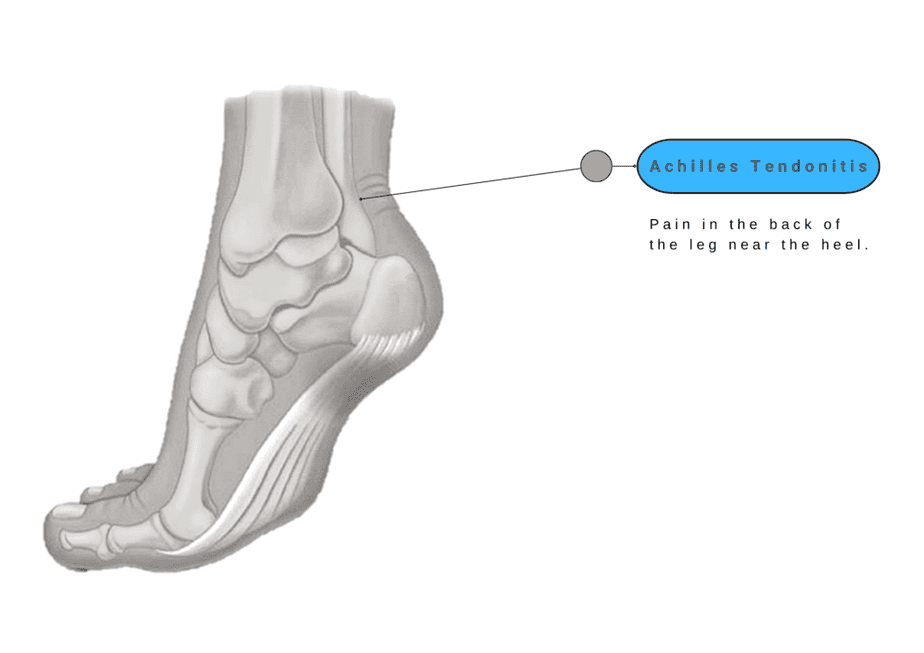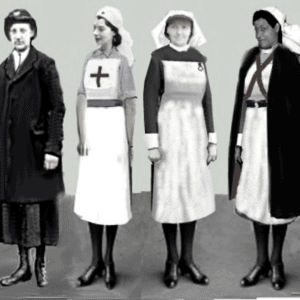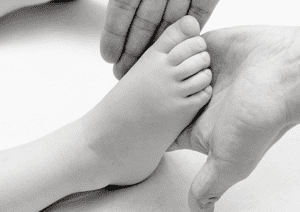Achilles Tendonitis
The achilles tendon is the thickest and strongest tendon in the body. It connects the heel bone to the calf muscles in the back of the lower leg. The main function of the tendon is to point the foot down and is necessary for efficient walking, running, jumping and climbing. Achilles tendonitis or tendinopathy is an injury caused by overuse of the achilles tendon where the tendon becomes damaged.

Usually, the first sign of achilles tendonitis is a mild, sharp pain or ache at the back heel after running or another high impact activity. Pain and swelling may be present along the tendon and usually gets worse with activity. Stiffness and tenderness may make it difficult to flex the foot up resulting in tightness of the tendon and a reduced range of motion.
If inflammation is present the heel area may feel warm to touch. Heel spurs (a bony lump) can also occur at the back of the heel.
A complete tear or rupture of the tendon can occur and requires immediate medical attention. Signs of this include a sudden pain in the heel or calf, difficulty to bear weight on the leg and there may be an audible snap.
Whilst the tendon can cope with a large amount of stress there are some risk factors that put it at a higher risk of damage. Men are more likely to injure their achilles tendon and the potential for injury increases with age. A flat or overly pronated foot puts additional stretch and stress on the tendon increasing the likelihood of injury or damage. As with most foot and ankle issues being overweight or obese increases the likelihood of problems.
High impact sports and activities increase the stress on the achilles and the risk of these activities causing damage is increased if poor footwear or equipment is used, inadequate training or poor technique is employed, a sudden increase in intensity of activity or activity is on hard or uneven ground. Tight calf muscles also put extra stress on the achilles tendon particularly where it inserts into the heel. Finally, a Haglund’s deformity where there is a bump of overgrown bone at the back of the heel can irritate the achilles tendon causing inflammation and pain.
Along with appropriate footwear an insole with a firm arch support and heel cushion can reduce the stress on the achilles tendon, helping to minimise the risk of achilles tendonitis and to ease symptoms. AWP recovery shoes make a great choice for post workout or the Dynamic works well for people who are on their feet all day. The increased heel height, shock absorption in the heel and arch support help to limit stress and strain on the achilles tendon.
The insoles we recommend for achilles tendonitis are: PRIMO (1), POSA (2), PELUCHE (3), PURA (5) or PRECISO (6).
Would you like to know more about common foot pain problems before making a choice? You may find one of the following blog articles useful:
Achilles Tendonitis Click here to read our ‘Foot Pain – Achilles Tendonitis?’ blog to find out more.
Bunions Click here to read our ‘Foot Pain – Bunions?’ blog to find out more.
Diabetic Neuropathy Click here to read our ‘Foot Pain – Diabetic Neuropathy?’ blog to find out more.
Fallen Arches Click here to read our ‘Foot Pain – Fallen Arches?’ blog to find out more.
Hammer Toes Click here to read our ‘Foot Pain – Hammer Toes?’ blog to find out more.
Heel Spurs Click here to read our ‘Foot Pain – Heel Spurs?’ blog to find out more.
Metatarsalgia Click here to read our ‘Foot Pain – Metatarsalgia?’ blog to find out more.
Osteoarthritis Click here to read our ‘Foot Pain – Osteoarthritis?’ blog to find out more.
Pes Cavus Click here to read our ‘Foot Pain – Pes Cavus?’ blog to find out more.
Plantar Fasciitis Click here to read our ‘Foot Pain – Plantar Fasciitis?’ blog to find out more.
Posterior Tibial Tendon Dysfunction Click here to read our ‘Foot Pain – Posterior Tibial Tendon Dysfunction?’ blog to find out more.
Tarsal Tunnel Syndrome Click here to read our ‘Foot Pain – Tarsal Tunnel Syndrome?’ blog to find out more.









